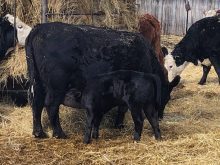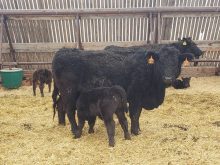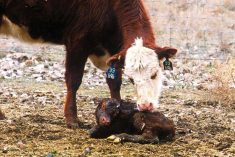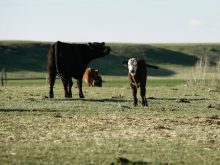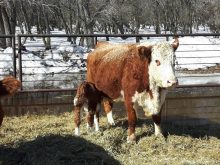March 22
This week we started our “fertilizer” project. We have big piles of old manure that Michael sorted out of the other debris when he cleared out the junk and old fallen-down sheds by the corrals. Heifer hill needs fertilizer the most since we haven’t been able to feed cows on it enough for them to spread their own “fertilizer.”
Lynn and Andrea took the hayfork off the big tractor and put the loader bucket on for loading manure. Then they got the little tractor started and hooked up the old manure spreader (that Stan worked on last year and got functional again).
Read Also

Harvest wraps up and fall work begins
At the Eppich famly ranch in western Saskatchewan, the fall harvest was successful with few breakdowns, cows and calves have been sorted and a new tractor has arrived
Jim started harrowing the other fields, pulling the harrow with his side-by-side. It does a better job than using the little tractor.
We had our first calf today — about 12 days early — but it was almost a disaster. One of the older cows was restless this afternoon, then at 4 p.m. I noticed she was lying next to the fence in the horse pasture. She was lying flat, and when another cow came up and sniffed her, the old cow kicked with a hind leg, and I realized she couldn’t get up. She was in a slight depression and a little on her back. I yelled at Lynn to help me, and ran out the door. Lynn grabbed a halter and rope in case we had to pull on the cow to get her upright. I sprinted to the top of the horse pasture and yelled at the cow and poked her with a sorting stick, startling her so much that she tried harder to get up. She flailed her head and legs and didn’t make it the first try, then as I kept encouraging her she tried again and lurched to her feet. Thankfully she wasn’t badly bloated yet. I brought her down to the calving pen.
She was very upset and not grateful at all for having her life saved — just angry that I was moving her away from the spot she’d chosen to calve. She settled down after an hour or so, and calved quickly just after 6 p.m. and the calf was soon up and nursing.
March 29
We had nice weather for several days, perfect for calving and spreading the rest of the manure. Spring break started Friday, so Dani had no school for a week. She and Roger helped with several projects, and sorted rocks and old hay twines out of the loads of manure we spread on heifer hill. They put the rocks in a ditch that’s become too deep; the rocks will keep it from eroding more.
Jim used his metal detector and a magnet with a handle to gather old nails and other metal debris that ended up in the manure piles to make sure none were left on the field to puncture a tire or end up in a hay bale to be eaten by a cow. Jim harrowed heifer hill after we got the manure spread (14 loads) and rocks and debris picked up.
Sunday night we had our second calf, and yesterday evening another one. Today was windy and cold. After we fed the cows, Andrea and I put up a hot wire around the calf houses in the pasture above the house and put hay for bedding into those little houses so the calves can have a sheltered dry place to sleep if the weather is bad. We like to keep the cows out of that area so they can’t eat the bedding out of the houses or rub on those old calf houses, or step on a calf that’s lying next to them.

April 8
Last Wednesday was Christopher’s 3rd birthday.
We had several more calves, and then Saturday we had two heifers calving — Sweet Pea and Pandemonium. They calved easily, within about 15 minutes of one another, and both were good mamas. Monday was cold and very windy. We’re glad we have good windbreaks in the second-day pens so the new calves can nestle down in those corners in the hay and be able to stay warm. We had three more cows calving that had to go in the barn. By evening it was snowing, and China Doll was calving, too, so we put one pair out in a second-day pen to make sure we’d have enough barn space if anyone else calved that night.
By the next morning two more were calving — Lillianni, nicknamed Alligator Eyes (our most aggressive cow when she calves, but easy to handle at other times) and her daughter — a first-calf heifer named Lilligator. We got all the other cows and calves out of the barn (except China Doll and her new baby that wasn’t quite ready for the nasty weather outdoors yet) and put new bedding in the vacated stalls so we could put the two new ones in.
Lilligator (the heifer) calved first. The calf was up within a few minutes and trying to nurse, but the new mama was confused. She was mooing and licking it, but kicked viciously when it tried to approach the udder. Fortunately, she didn’t connect with the calf! She soon settled down, however, and the calf was nursing.
The older cow wasn’t as far along in labour yet, so Andrea went home to rest for an hour. When she came back we went out to check on old Alligator Eyes. Andrea got to the barn first; I was a little slower getting my boots and coat on, and when I went out the door I could hear her yelling for help. I ran out there and found her on the partition panel trying to get the sac off the newborn calf’s head with an old pitchfork handle (that we use as a weapon in the barn when necessary) because she didn’t dare get in with that cow. The calf had just been born as she went in the barn, but the sac and fluid were still around its head and it couldn’t breathe.
This is a cow that will eat you alive when she first calves; it always takes two people if we have to do anything with the calf. So I jumped in there and clonked the cow a few times with the pitchfork handle while Andrea grabbed the calf and pulled the membrane away from its head and got it breathing.
Calving is winding down. Last night I put the remaining two cows in the calving pen where I could watch them closely.
April 20

It started snowing and blowing before they got the fence finished. Our last cow started calving and we put her in the barn after she broke her water. She calved swiftly — a bull calf. We’re done calving! From start to finish, calving took only 20 days. That was our shortest calving season ever; all the cows must have bred on their first cycles.
These past 10 days have been less hectic, just feeding cows, getting caught up on a few projects, etc. Charlie came out a few times to help. Jim (and his dog Ezra) harrowed the orchard and horse pasture, pulling the harrow with his side-by-side. That dog loves to be the co-pilot whizzing around the fields!




